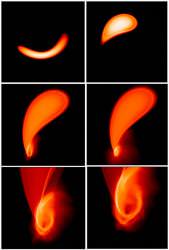It’s one of the big mysteries in astronomy. There are stellar mass black holes and the supermassive variety, but nothing in between. Where are all the intermediate mass black holes? Astronomers theorize that they could be located in globular star clusters, but nothing definitive has turned up yet. A team of researchers think they’ve come up with a new way to detect intermediate black holes – a way to see them for billions of light-years.
First a little background. When white dwarf stars are in a close binary system with another star, they pull off material, piling it up on their surface. When the white dwarf reaches 1.4 times the mass of our Sun, it reignites in a reaction that happens so quickly the star detonates. This is a Type 1a supernova, and astronomers use them as standard candles to determine distance since they always explode with the same amount of energy.
But researchers from UC Santa Cruz think there’s another situation where you might get a supernova explosion from a white dwarf: when it’s orbiting an intermediate mass black hole.
If a black hole has just the right amount of mass – 500 to 1000 times the mass of the Sun – a white dwarf might get torn apart in a particularly spectacular way. As the dwarf passes the whole, it would get compressed and heated. Its formerly dead material would now have the pressure and temperature to reignite in a powerful explosion similar to a Type 1a supernova.
The explosion would eject more than half of the debris into space, but the rest would fall back into the black hole and form an accretion disk around it. This disk would then emit X-ray radiation detectable by space telescopes like the Chandra X-Ray Observatory.
“This is a new mechanism for ignition of a white dwarf that results in a very different type of supernova than the standard type Ia, and it is followed by an x-ray source,” said Enrico Ramirez-Ruiz, assistant professor of astronomy and astrophysics at the University of California, Santa Cruz.
According to Ramirez-Ruiz, events like this would happen in about 1% of Type 1a supernova explosions. Future surveys, such as the Large Synoptic Survey Telescope, due for completion in 2013, is expected to discover hundreds of thousands of Type 1a supernovae each there. With those kinds of numbers, there should be many of these intermediate black hole interactions detected.
The mass of the white dwarf doesn’t really matter. They ran various sized stars through their simulation and found that you would still get the same outcome; the white dwarf would be tidally disrupted and then it would detonate.
Original Source: UC Santa Cruz News Release


The supernova mechanism is so unusual that we should not confuse it with a Type 1a. Those always explode with the same energy because they always have the same mass. This one will not.
The Type 1a is useful because it tells us exactly how far away the object lies. If a supernova looks like a Type 1a, but does not have its energy, then we need to reevaluate our distance estimates based largely on these standard candles. It might even affect our understanding of the expansion of the universe.
Totaly agreed David Madison, Sr. The 1% estimate of Post Nova Xray supernova could greatly alter proximity measurements in much of the universal age, speed and distance estimates. Now, do we have the data to identify the non-Type 1a nova previously misdentified?
There is already a mechanism that can potentially disrupt our standard candle theory. It is the combination or collision of two subcritical size white dwarfs resulting in a supernova from a star which achieved a mass in excess of 1.4 solar masses – the magic number for type Ia. This is likely to be rather rare, but it seems to be an explaination for at least one moderately recent SN that was apparently a Ia yet seemed a bit too bright for the distance.
If this is on the order of 1% or less, it probably will not severely affect measurements, but if somehow it was more in the 10% or greater it could really affect them.